Rock gardens are a great way to add some character and charm to your outdoor space while keeping it low-maintenance. They can be designed to suit any style, from modern to rustic, and can feature various plants, stones, and layouts. Here are 19 creative ideas to inspire your next rock garden project, turning your yard into an inviting and beautiful retreat.
Boulders as Focal Points
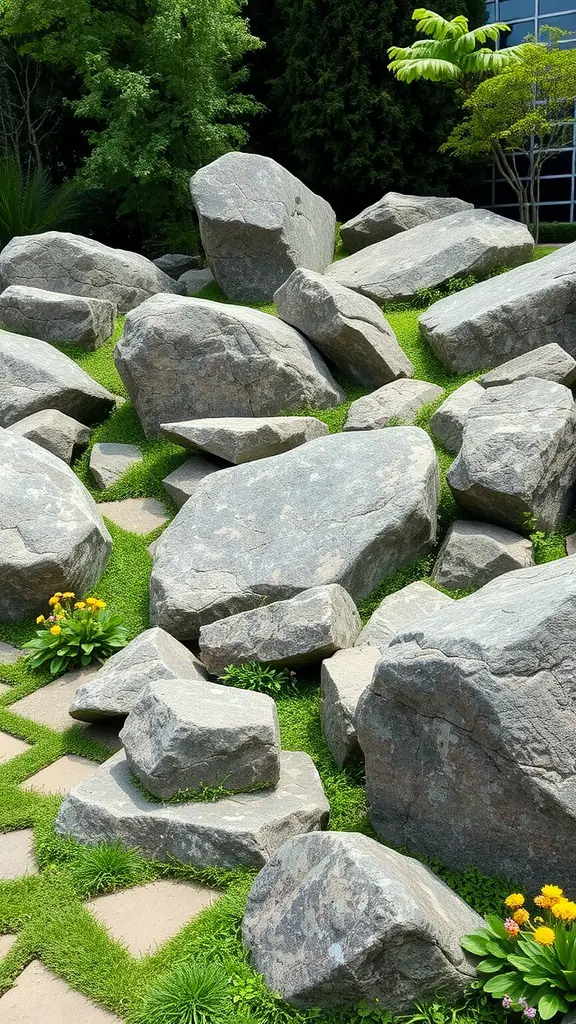
Boulders can transform any rock garden into a stunning landscape. They add a sense of strength and permanence. In the image, large, rough stones are scattered across a lush green lawn. They create natural pathways and visual interest.
The different sizes and shapes of the boulders invite exploration. They guide the eye through the garden. Plants peek through and around the stones, softening the look and adding color. Bright yellow flowers stand out against the gray rocks, bringing a cheerful vibe.
When using boulders in your garden, think about placement. Grouping them in clusters can create a more natural appearance. You can also use smaller stones to fill in gaps. This makes the garden feel inviting and complete.
Mini Water Features
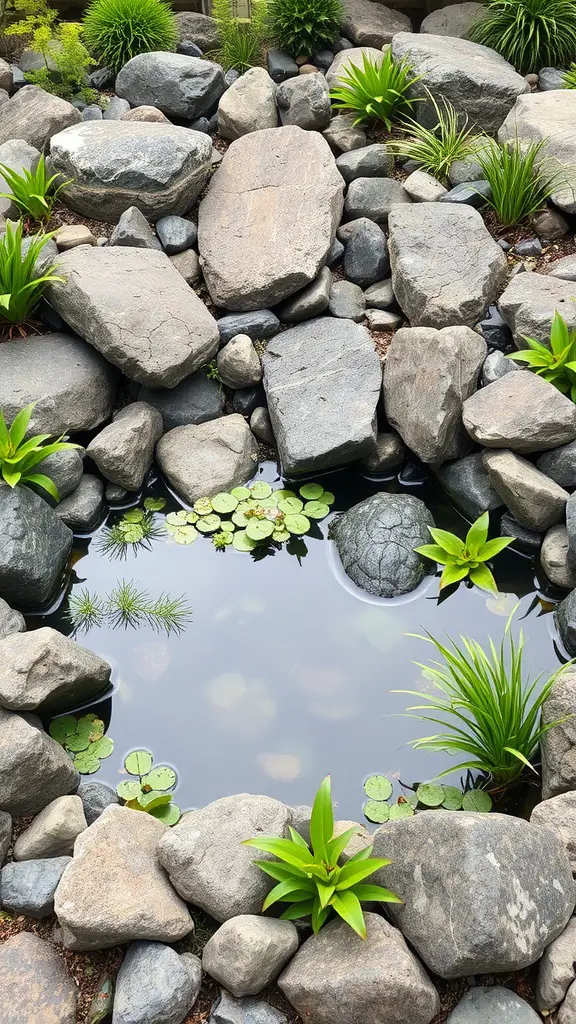
Mini water features can transform your rock garden into a peaceful retreat. This image showcases a lovely small pond surrounded by various rocks and vibrant green plants. The calm water reflects the greenery, offering a serene spot that invites relaxation.
Using rocks in landscaping around the water feature adds texture and a natural look. The lily pads floating on the water enhance the visual appeal, creating a spot where you can enjoy the beauty of nature. Plus, this setup requires less maintenance than larger water features.
Incorporating mini water features like this into your garden can help attract wildlife, such as birds and butterflies, making your space even more lively. It’s a simple way to add charm and tranquility to your outdoor area!
Rock Border Flower Beds
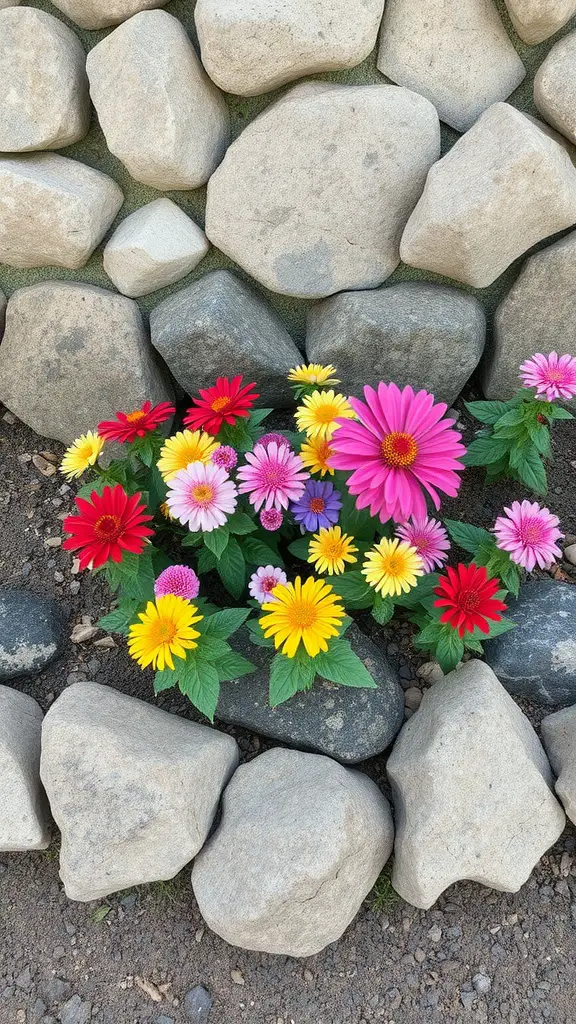
Rock border flower beds are a charming way to define your garden space. They create a clean and structured look while providing natural beauty. This image shows a vibrant arrangement of flowers framed by smooth stones.
The colorful flowers, including pink, yellow, and red varieties, bring life to the rocky border. They thrive together, adding a lively touch to the outdoor area. This specific design can really make your garden pop while keeping things organized.
Using rocks not only serves a practical purpose but also enhances the overall aesthetic. The contrast between the sturdy stones and soft petals creates a delightful visual effect. Plus, it helps with soil retention and can prevent weeds from encroaching on your blooms.
Whether you choose to go with a single color scheme or mix various shades, rock border flower beds can be tailored to your taste. It’s an easy way to add a bit of character to your garden.
Colorful Alpine Plants
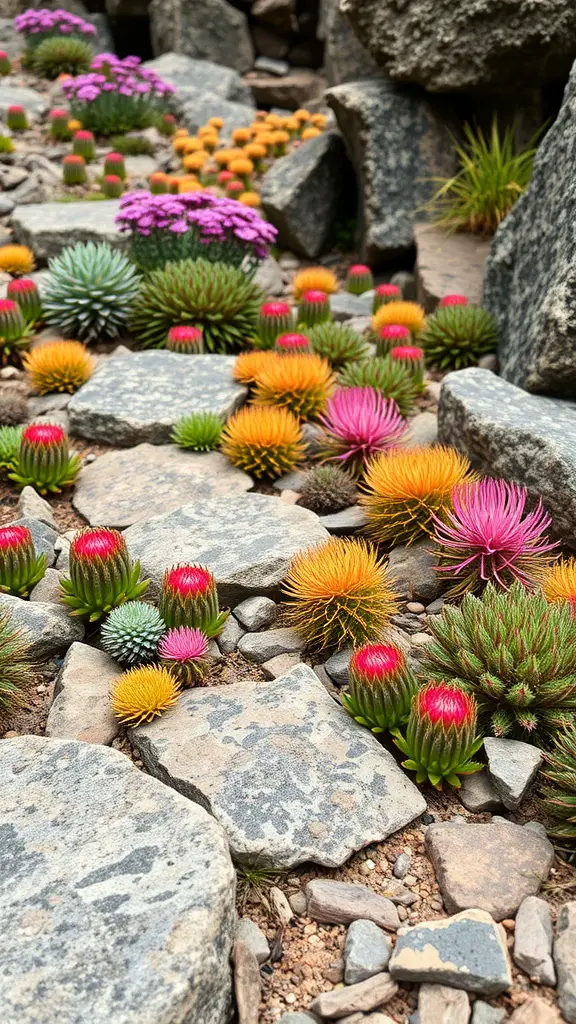
Colorful alpine plants can really brighten up your rock garden. These hardy beauties thrive in rocky, well-drained soil and often come in vibrant shades. Imagine walking through a landscape filled with clusters of bright pinks, oranges, and greens, surrounded by rugged stones.
In the image, you can see a mix of these colorful plants nestled among smooth stones. The cheerful blooms and unique foliage create a lively contrast against the earthy tones of the rocks. Not only do these plants add visual interest, but they also create a stunning focal point in any garden.
Using alpine plants is a smart choice for those looking to add low-maintenance greenery. They are resilient and can withstand various weather conditions, making them perfect for rock gardens. Plus, the diversity in color and shape keeps your landscape looking fresh and inviting throughout the seasons.
Zen Gravel Paths
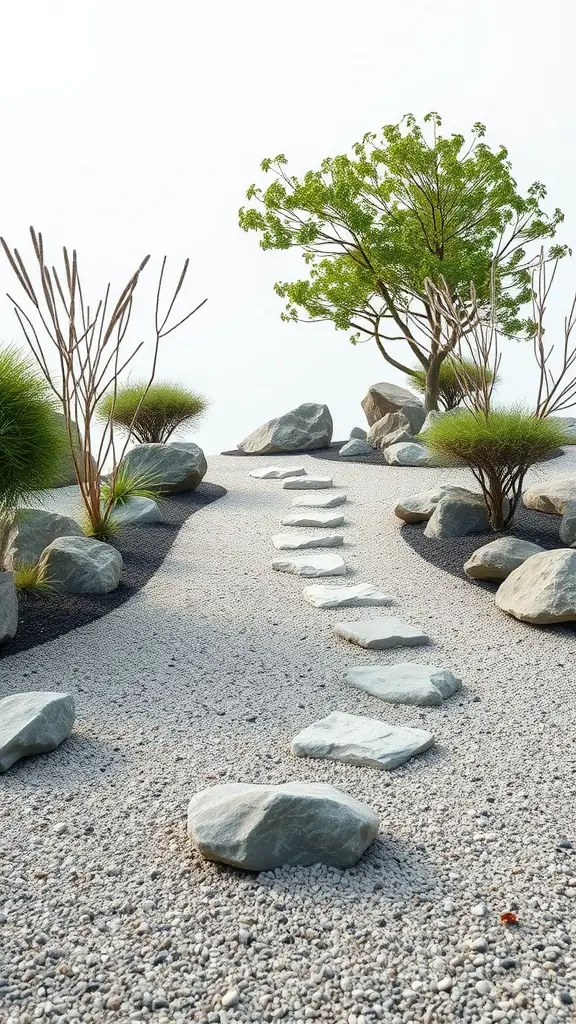
Zen gravel paths are a wonderful way to create a peaceful atmosphere in your garden. The image showcases a beautifully designed pathway made of smooth stones and fine gravel, leading through a carefully arranged landscape.
With a gentle curve, the path invites you to wander and explore. The surrounding rocks and plants add texture and interest, enhancing the overall aesthetic. This setup encourages mindful walking, allowing you to take in the beauty of nature.
The gravel acts as a natural drainage system, keeping your garden looking fresh and neat. It’s low maintenance, making it a practical choice for busy gardeners. The greenery and stones combine to create a tranquil space perfect for relaxation or meditation.
Incorporating a path like this can transform any outdoor area into a serene escape. It’s simple, yet effective, and can be adapted to fit different garden styles. Whether you want to connect various areas of your garden or create a focal point, a zen gravel path is an excellent choice.
Terraced Rock Gardens

Terraced rock gardens can really bring charm to your outdoor space. They create a natural flow, guiding the eye up through different levels. Imagine a beautiful stone staircase leading you through vibrant flowers and lush greenery.
The image shows a stunning example of this idea. Large rocks are combined with plants, forming steps that invite you to explore. Each level offers a different view and unique plants, making it visually interesting.
Plants like ferns and vibrant flowers add pops of color, while the rocks provide texture and structure. This mix not only enhances the garden’s beauty but also creates a habitat for butterflies and other wildlife.
When planning your own terraced rock garden, think about the layout and how to incorporate your favorite plants. You can even include pots for added variety. With a little creativity, you can turn an ordinary slope into a stunning terraced landscape.
Succulent and Cactus Arrangements
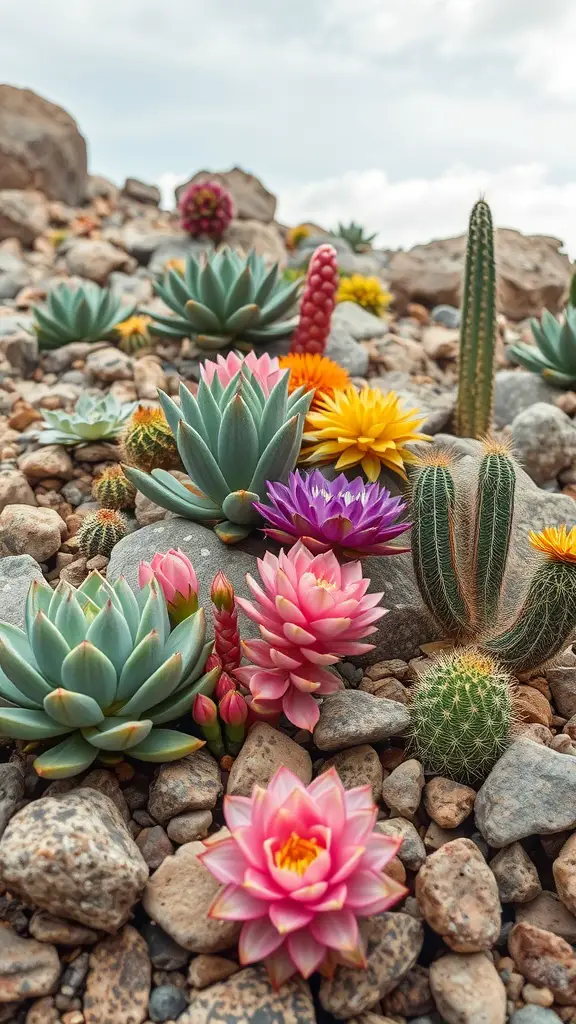
Creating a rock garden with succulents and cacti is a fun way to add color and texture to your outdoor space. The image shows a vibrant mix of plants nestled among stones, showcasing how these hardy species thrive in rocky environments. You’ll notice the various shapes and colors, from the soft greens of the succulents to the bright pinks and yellows of the flowers.
These plants are perfect for low-maintenance gardens. They require minimal watering and can withstand harsh conditions. The arrangement in the image offers a lively aesthetic, combining different varieties like Echeveria and cacti. Mixing various plants not only adds interest but also makes it easier to create a visually appealing design.
Consider using a variety of stones and pebbles to complement the plants. The contrasting textures bring out the beauty of each succulent and cactus. You can create pathways with larger stones or use smaller pebbles as a base for the plants. This layout invites exploration and makes the garden feel more inviting.
Whether you have a small balcony or a sprawling yard, succulent and cactus arrangements can fit into any space. They are versatile and can be arranged in pots, rock beds, or even as part of a larger landscape design. Get inspired by the image and let your creativity flow!
Layered Stone Outcroppings
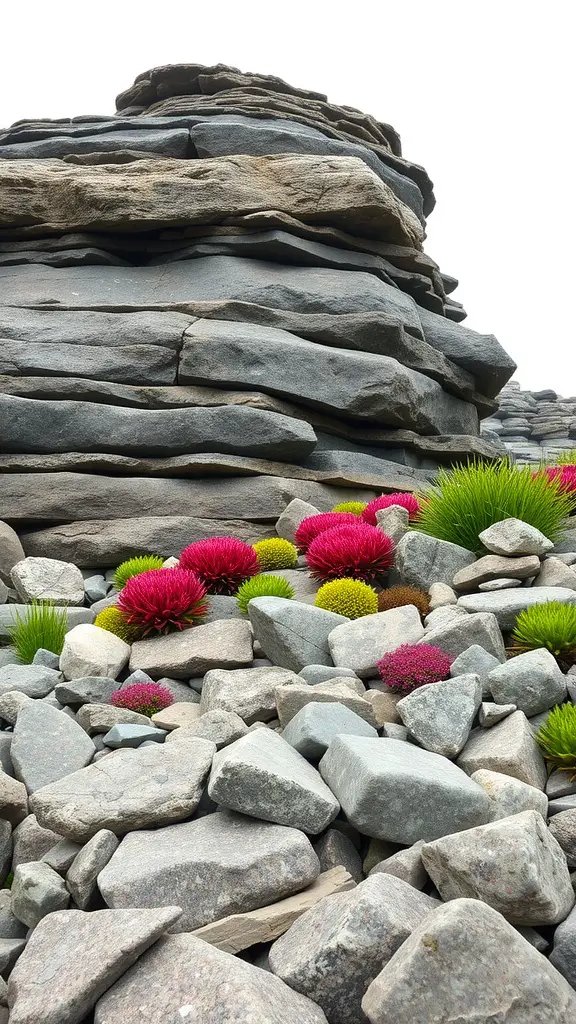
Layered stone outcroppings create a stunning focal point in rock gardens. The image showcases a striking arrangement of large, flat stones stacked in a natural pattern. This design gives a sense of depth and texture, making the garden feel more dynamic.
The colors of the stones range from dark grays to lighter hues, providing a beautiful backdrop for the vibrant plants. The pops of pink and green from the succulents add lively contrasts, drawing the eye and adding a splash of color.
Incorporating these stone layers not only enhances visual appeal but also helps with drainage and soil stability. They can create small microclimates for plants, allowing you to introduce a variety of species that thrive in different conditions.
For anyone looking to spruce up their garden, consider using layered stones as a base. This technique is simple to implement, and the results are sure to impress!
Artistic Stone Pathways

Stone pathways can bring a unique charm to your rock garden. This image showcases a winding path made of various colored stones, guiding you through a serene landscape. The stones are set against a backdrop of large boulders and lush greenery, creating a harmonious and inviting atmosphere.
The pathway is not just functional; it’s also a work of art. The different colors and shapes of the stones add personality and flair. This artistic approach makes the pathway a focal point, encouraging exploration and movement through the garden.
Surrounding the stones are patches of soft grass and vibrant plants, enhancing the natural look. This combination of textures invites you to stroll along the path, making your outdoor experience more enjoyable. You can almost feel the tranquility of nature as you imagine walking here.
Incorporating artistic stone pathways into your rock garden can elevate the visual appeal while providing a clear route. Whether you want a simple design or something more intricate, there are endless possibilities to suit your style.
Ground Cover Solutions

When designing a rock garden, ground cover is a key element that brings life to the space. In the image, you can see a blend of rocks and green plants peeking through. This combination adds texture and color, making the area inviting.
Choosing the right ground cover plants can enhance your rock garden’s look. Low-growing varieties are perfect for filling the gaps between stones. They help prevent weeds and add a lush feel to the rocky surface.
Consider options like creeping thyme or sedum. These plants thrive in rocky environments and require minimal care. Their vibrant flowers can also attract pollinators, adding to the garden’s ecosystem.
Using ground cover effectively can create a harmonious balance between hardscaping and softscaping. It’s not just about aesthetics; it also helps with soil retention and moisture control. This way, your rock garden can thrive with less effort.
Vertical Rock Gardens

Vertical rock gardens are a fantastic way to add greenery and texture to any space. This design is perfect for those looking to maximize their area without taking up too much floor space. The image showcases a stunning arrangement of stones, with various plants seamlessly integrated into the structure.
The rocks create a natural backdrop, while the greenery adds a refreshing touch. You can see different types of plants nestled among the stones, some hanging down gracefully and others standing tall. This layering effect not only adds visual interest but also brings a sense of life to the garden.
Creating your own vertical rock garden can be both fun and rewarding. Start with a sturdy wall or fence and choose a mix of stones that vary in size and color. Then, select plants that thrive in your climate and can grow in small spaces. Don’t forget to include trailing plants to soften the look and add depth.
Rock Wall Garden Structures
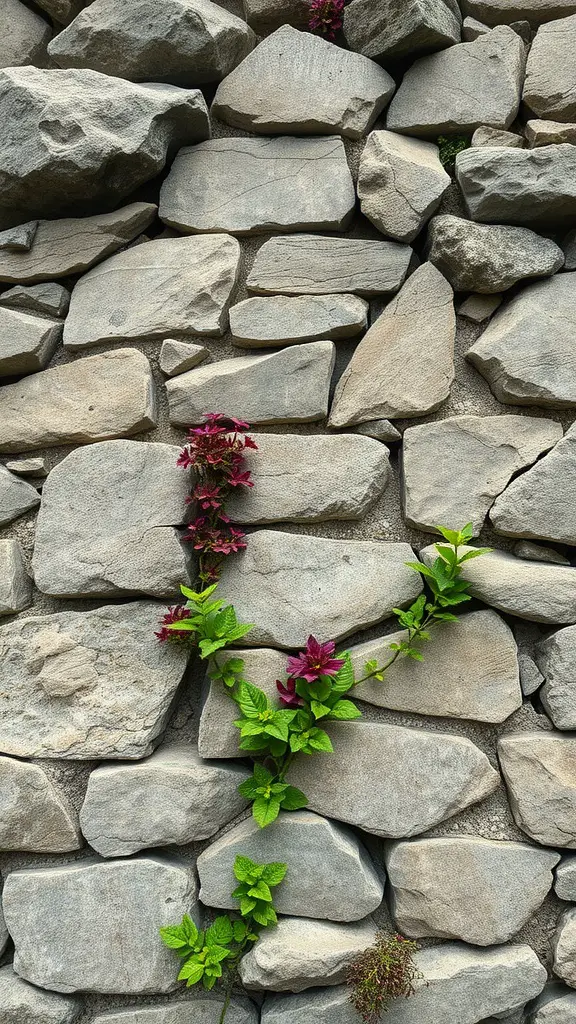
Rock walls can bring a unique charm to your garden. This image showcases a beautifully constructed stone wall, where the varying sizes and shapes of the rocks create a natural yet structured look.
The greenery that climbs the wall adds a burst of life against the stone backdrop. Vines and colorful flowers peek out, softening the harshness of the rocks. This contrast is visually appealing and enhances the overall aesthetic of your outdoor space.
Using rock walls in your garden can also be functional. They can help with erosion control, create terraces, or simply serve as a stylish backdrop for your plants. With the right plants, you can create a vibrant display that changes with the seasons. This setup is perfect for those looking to combine beauty with practicality.
Creative Use of Driftwood
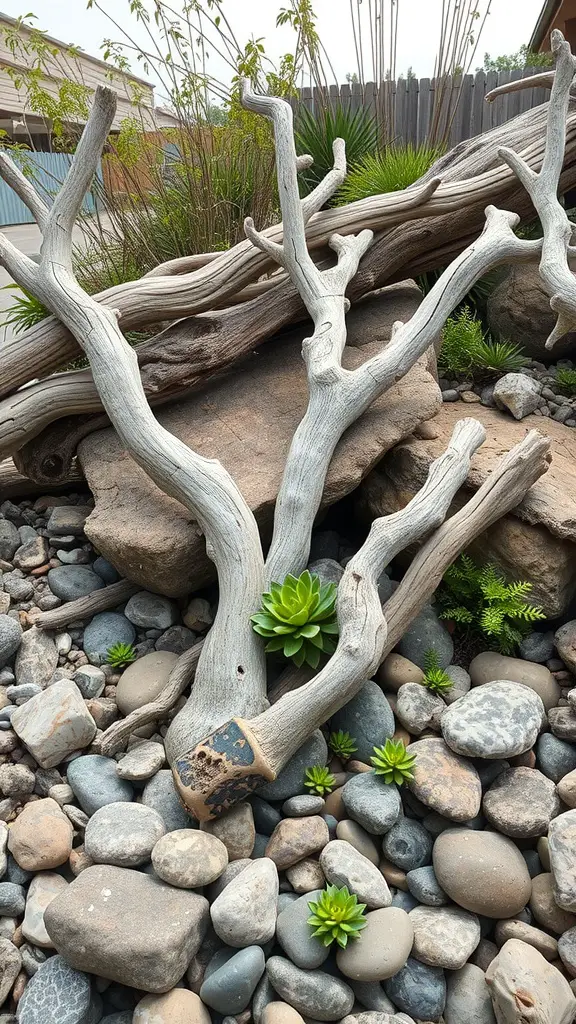
Driftwood brings a unique touch to rock garden landscaping. This image showcases how elegantly driftwood can blend into a natural setting. The gray tones of the wood contrast beautifully with the smooth pebbles and vibrant greenery around it.
Incorporating driftwood adds character and depth to your garden. The twisted shapes of the wood create visual interest and can serve as focal points. You can position it amid rocks or use it to frame plants, like the succulents seen here.
Using driftwood also allows you to play with textures. Pairing the rough, weathered wood with smooth stones feels pleasing to the eye. This combination is great for achieving an organic look, making your space feel like a slice of nature.
Remember to select pieces that resonate with your personal style. Each piece of driftwood tells a story. Use them in creative ways—perhaps as a natural sculpture or even a trellis for climbing plants. The possibilities are endless!
Seasonal Color Changes
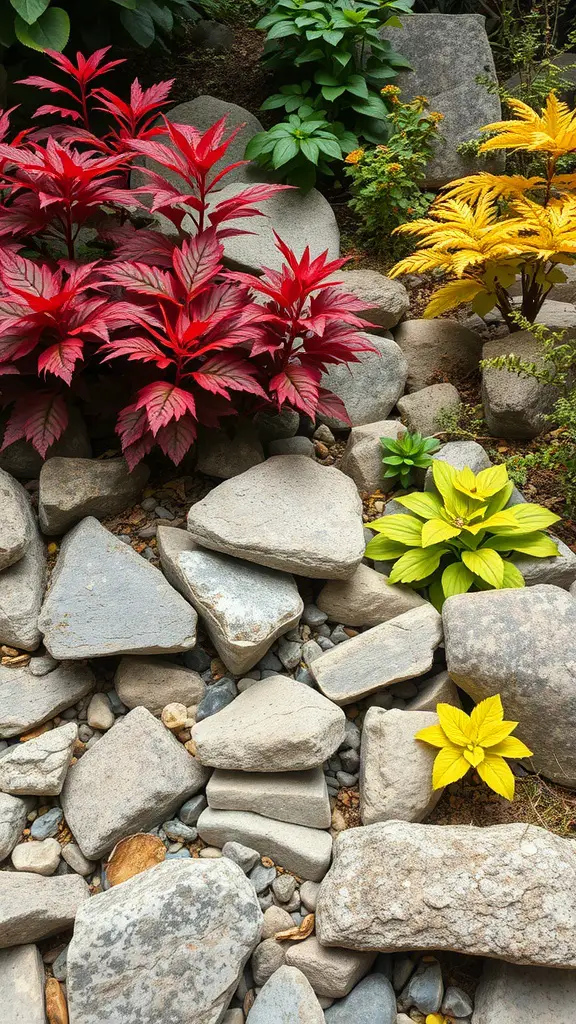
Rock gardens are fantastic for showcasing seasonal color changes. This image highlights how vibrant foliage can create a stunning contrast against the cool tones of rocks. The bright reds, yellows, and greens add life to the stone landscape.
In this setup, you can see striking red plants, which bring warmth and energy. The yellow foliage on the right offers a cheerful pop, while the lush green leaves balance the scene. Together, these colors work harmoniously to create an inviting atmosphere.
As seasons change, so will the colors in the garden. Some plants may bloom in spring or summer, while others showcase their beauty in autumn. This variety provides visual interest throughout the year, making every visit to your garden feel fresh and new.
Wildflower and Rock Combinations

Mixing wildflowers with rocks creates a unique and charming landscape. The image shows vibrant yellow flowers peeking through gray stones, offering a lovely contrast. This combination brings life to a rock garden, making it visually appealing and full of character.
Wildflowers are often hardy and can thrive in rocky areas where other plants might struggle. They add color and texture to the landscape. Using different types of rocks can enhance the natural beauty of these blooms, creating a balanced and inviting space.
When planning your rock garden, consider the placement of rocks and flowers. Grouping wildflowers in clusters can create a more natural look. Ensure the flowers have enough space to grow while still allowing the rocks to be a focal point.
This approach not only beautifies your garden but also supports local wildlife. Pollinators like bees and butterflies are drawn to wildflowers, making your garden a lively habitat.




